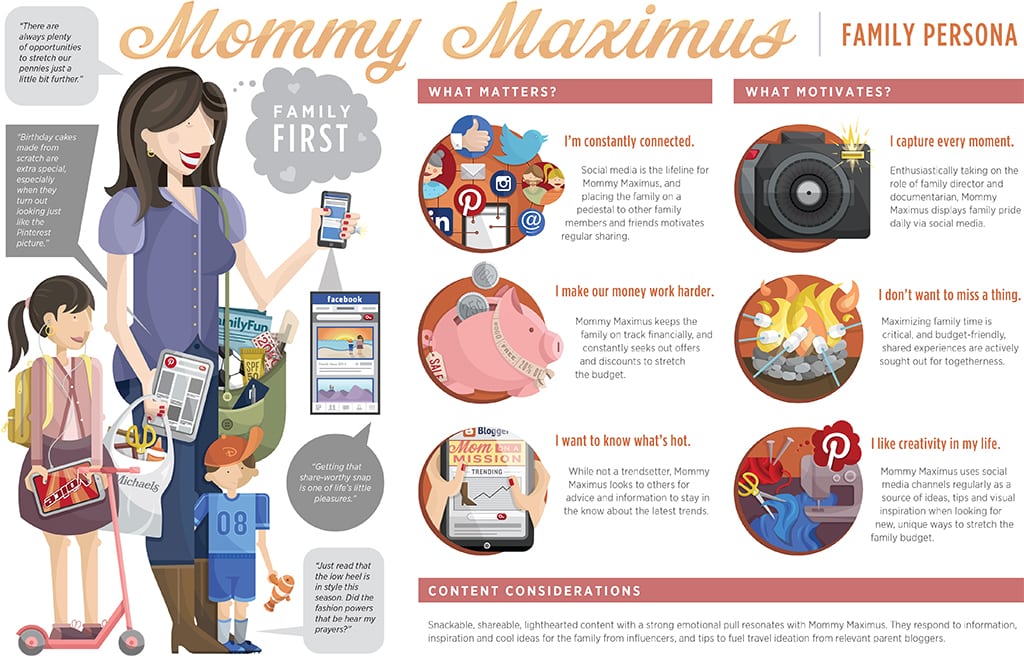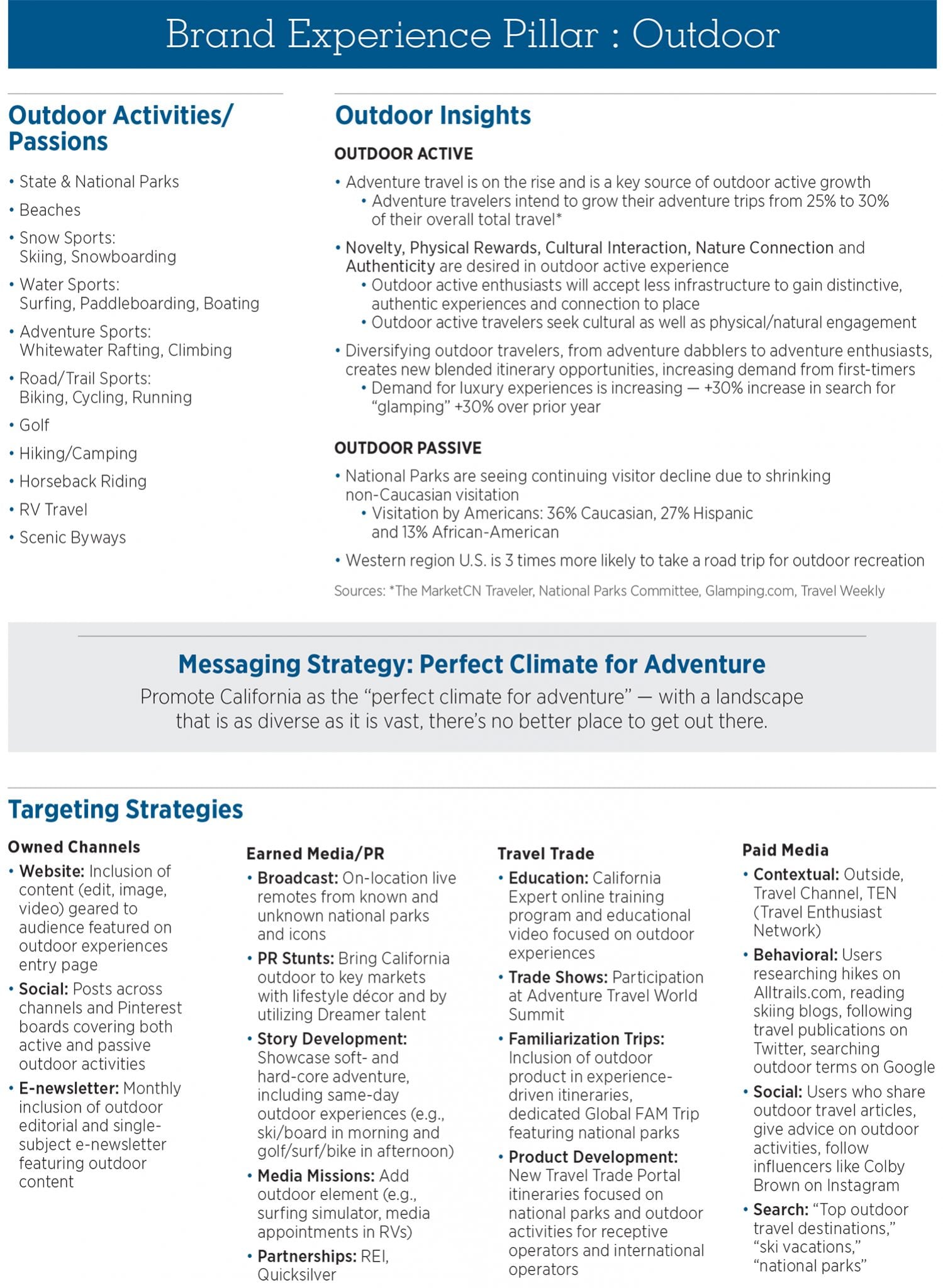Skift Take
The shift from analyzing target customer demographics to consumer psychographics is taken to a new level with this strategic marketing and communications plan.
Last month, Visit California launched its 226-page Dream Big Dividend Work Plan for the 2015/2016 fiscal year, constituting the most comprehensive marketing, communications, and operational strategy framework for the organization to date.
The breadth of the strategy roadmap is the result of Visit California’s Dream Big Dividend initiative last year. In a statewide vote, tourism industry stakeholders approved a large jump in funding for the destination marketing organization (DMO) to $100 million per annum. In comparison, the 2013/14 budget allotted $50 million, well behind Las Vegas, Florida, New York, and Orlando at the time.
The Visit California Work Plan outlines how the DMO should spend that $100 million.
Due to the scope of this report, it would require a whole series of posts to deconstruct its deliverables. For our purposes here, we’re looking solely at how Visit California breaks down consumer target audience demographics and psychographic profiles. For reference, here are some links to various partial sections of the Work Plan.
Visit California’s consumer target audiences have been “identified to provide optimal ROI potential for the industry’s investment.” These audiences are identified by a three-layer pyramid beginning at the top with a “Broad Global Brand Target” defined by age, income and desire to travel. The middle layer consists of “Opportunity Brand Targets” that hone in on key demographic and psychographic niches. The bottom layer describes “Passions-Based Targets” that aggregate people by interest.
Beginning with the broad global brand target customer, he or she is over 18 years old, lives in the top one third of household incomes, and vacations at least once annually.
Moving down one layer to the opportunity brand target level, Visit California expands the definition of its target consumers with the following five personality traits:
- Creative — They have an active imagination
- Curious — They want to explore and learn
- Open-minded — They embrace the new and different
- Authentic — They want to stay true to themselves
- Youthful — They want to feel young
At this point, the DMO then delineates that holistic target set into two sub-groups: family travelers and aspirational travelers.
“Underneath the global brand target we have the opportunity brand targets, and what we found is, as we looked at them, two demographics and really psychographic filters rose to the top,” says Lynn Carpenter, VP of marketing for Visit California.” Those are the family and the super affluent. They have very different mentalities, very different media plans that go around them, and very different creative.”
At first glance, segmenting target customers for an entire state into family and luxury travel buckets seems somewhat over-simplified, but how the DMO then branches out from there is where things get interesting.
The two traveler segments are further extrapolated by: What matters to them, what motives them, and what type of content they tend to respond to.
Following that, the Work Plan offers a series of market research overviews specific to each segment, and then outlines an overarching media marketing strategy to approach each segment.
Mommy Maximus
Visit California’s family traveler is personified by what the DMO calls “Mommy Maximus”—the busy working mother who puts family before all else and makes the bulk of family travel decisions.
The three primary things that matter to her are: “She wants to be constantly connected, she wants to make her money work harder, and she wants to know what’s hot [trendy].”
Mom is motivated by: “She wants to capture every moment digitally, she doesn’t want to miss a thing, and she likes creativity in her life.”
Her content preferences are: “Snackable, shareable, lighthearted content with a strong emotional pull resonates with Mommy Maximus. They respond to information, inspiration and cool ideas for the family from influencers, and tips to fuel travel ideation from relevant parent bloggers.”
The next page of the Work Plan discusses how to strategically market to Mommy Maximus, based on a wide range of insights collected from industry sources, including Skift. The final messaging strategy is:
“Promote California as the ‘Ultimate Family Playground’ with theme parks aplenty, plus state and national parks, beaches, zoos, aquariums, museums and more. It’s a place that thrills kids and brings out the kid in the adults too.”
The Confident Connoisseur
For the luxury travel market, Visit California’s target affluent customer is personified as the “Confident Connoisseur.” Here is a bullet list breakdown paralleling the same marketing profile architecture used for Mommy Maximus:
- What matters to the Confident Connoisseur: “I live life to the fullest, I’m at the top of my game, I’m sharing, not bragging.”
- What motivates the Confident Connoisseur: “I’m wallet savvy, I’m in pursuit of what’s next, I seek luxury without pretense.”
- Content consideration: “Sense of discovery is important to the Confident Connoisseur. They respond well to content that resonates and pulls them, from visual stimuli and native advertising to tools that help uncover ‘what’s next’ and messaging from approachable, peer-like influencers.”
- Messaging strategy: “Promote California as a place of ‘Laid-Back Luxury’ with a distinct vibe and unparalleled roster of distinct upscale travel experiences. It’s a place that offers luxury without the pretense.”
Passions-Based Personas
With the family and luxury travel target audiences clearly defined, Visit California then differentiates five specific travel interests potentially applicable to Mommy Maximus and Confident Connoisseur, including: outdoor active, outdoor passive, culinary, entertainment, and culture.
Each one of them are given a name, or “passions-based persona,” aligned with the list above: Avid Adventurer, Natural Nurturer, Savvy Sophisticate, Media Maven, and Cultured Cosmopolitan
The Visit California Work Plan begins the personas section with: “Within passion-based targeting, media plans are built to reach the intended audience based on specific interests and web actions that define them within each brand experience pillar. Unlike the Super Affluent and Family opportunity brand targets, these audiences are defined by who they are and how they act. No demographic information is used for targeting.”
Without going into all five personas, we’ll examine the Avid Adventurer and Natural Nurturer personas:
- What matters to the Avid Adventurer: “I’m up for anything, I keep up on the go, I’m tuned in.”
- What matters to the Natural Nurturer: “I stay involved and engaged, I spend wisely, I want to connect and share.”
- What motivates the Avid Adventurer: “I’m looking to grow, I’m self-assured, I won’t waste a moment.”
- What motivates the Natural Nurturer: “I seek authentic adventure, I’m the family memory maker, I stay true to what matters.”
- Content consideration for the Avid Adventurer: “Authentic action stimuli, off-the-beaten-path content and relevant innovation (tech or gear) resonate with the Avid Adventurer. They respond to native advertising, as well as approachable influencers from the action genre.”
- Content consideration for the Natural Nurturer: “The Natural Nurturer is interested in family-oriented as well as ‘me’ content. Quick lists of what a destination has to offer will allow them to dig deeper. Details, activities and challenges that they can share with their family will fuel their curious, adventurous side.”
- Messaging strategy for both personas: “Promote California as the ‘Perfect Climate for Adventure’ with a landscape that is as diverse as it is vast. There’s no better place to get out there.”
“There’s some really interesting learning here,” says Carpenter. “I’m a total info nympho and I believe in the power of analysis and information to provide real insight. Not just to sell a plan, but to actually provide you with strategic direction. You know what I mean? I feel like sometimes in the world people use data to backup their plan to do whatever they want to do.”
Following all of that, the Visit California Work Plan outlines targeting strategies for each persona, categorized by: Owned Channels, Earned Media/PR, Travel Trade and Paid Media. See the graphic below.
The 2015/2016 Visit California Work Plan is basically a blueprint for the future of DMO marketing and communications. Almost every DMO can most likely use this to inform their own target audience research and strategy.
Greg Oates covers tourism and hospitality development.
The Daily Newsletter
Our daily coverage of the global travel industry. Written by editors and analysts from across Skift’s brands.
Have a confidential tip for Skift? Get in touch
Tags: visitcalifornia
Photo credit: Visit California's hero mom target customer is connected, value-driven and wants to know what's trendy. Visit California

